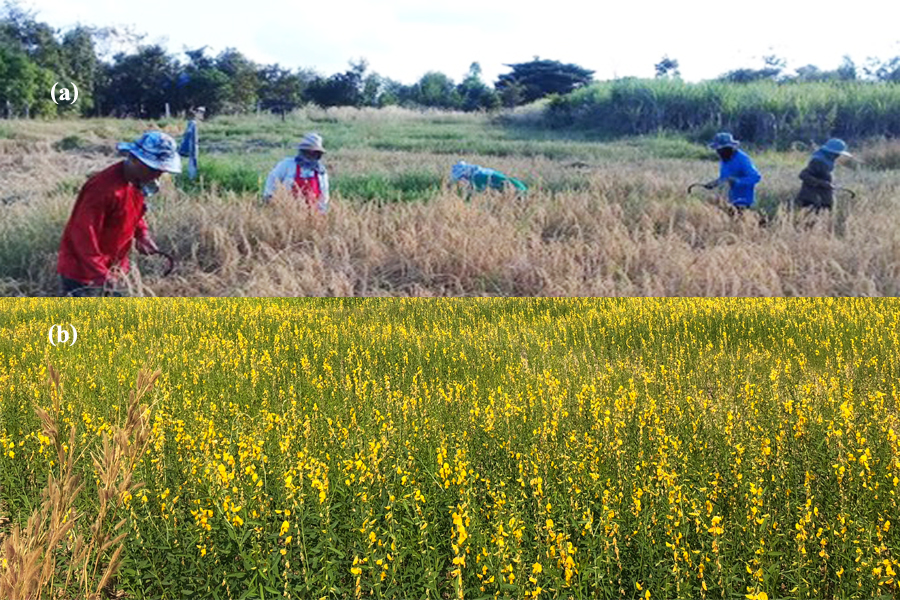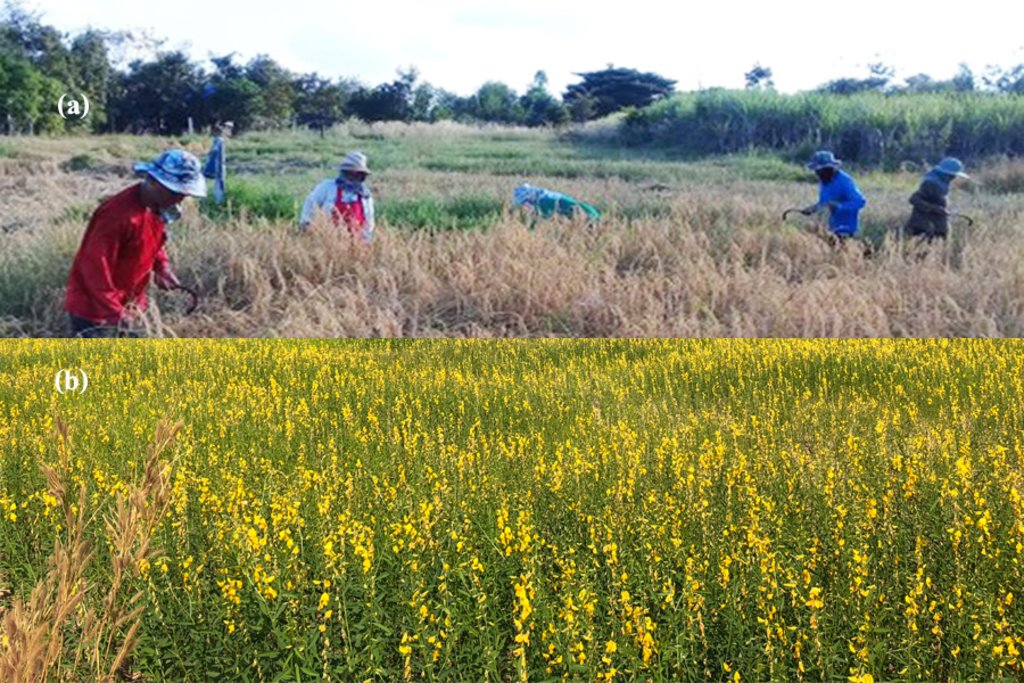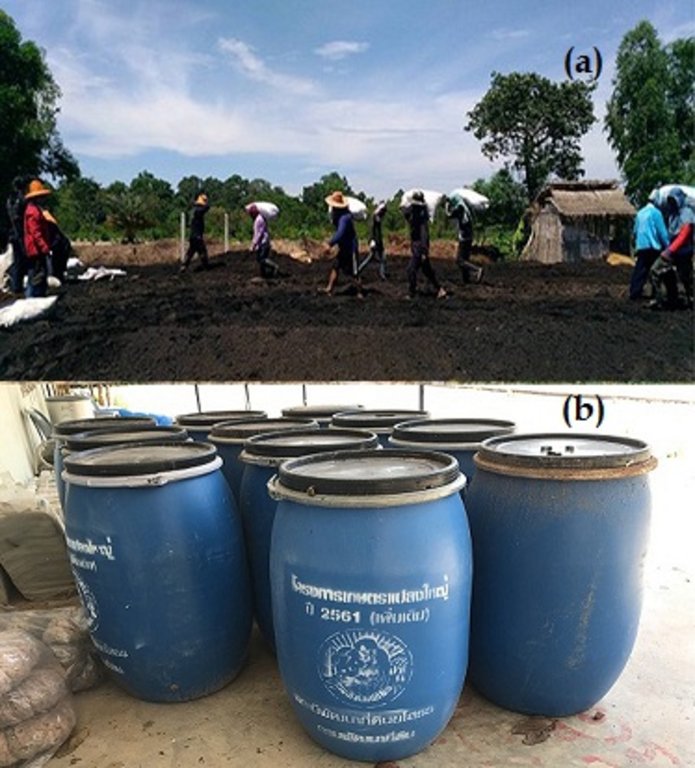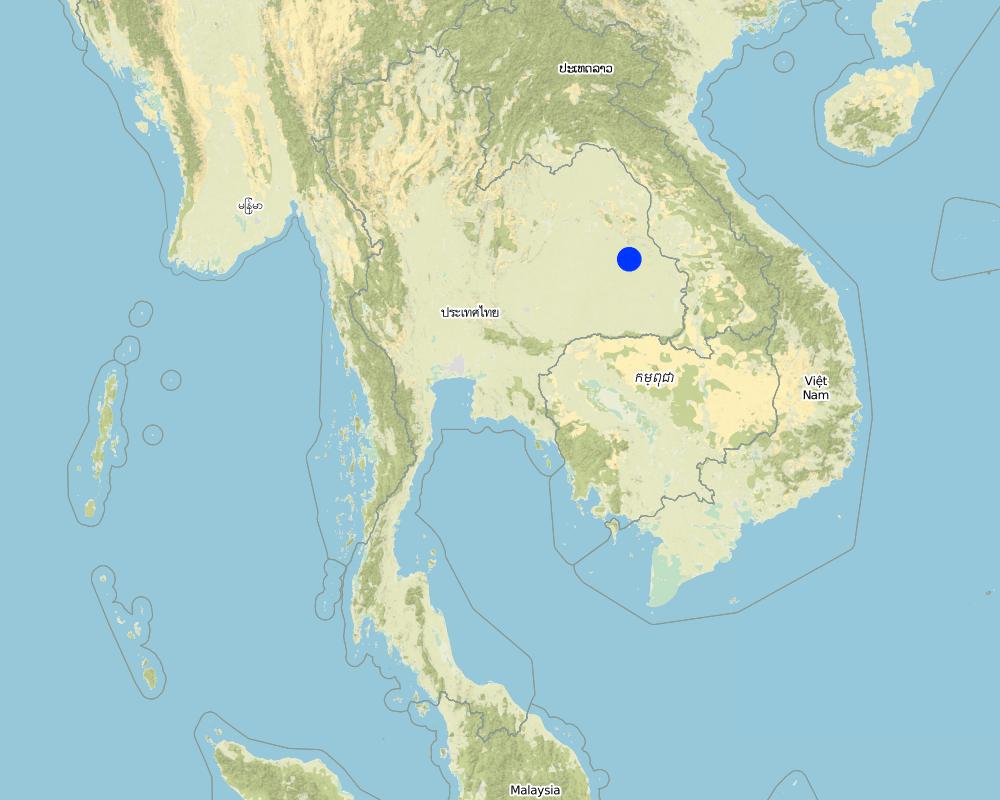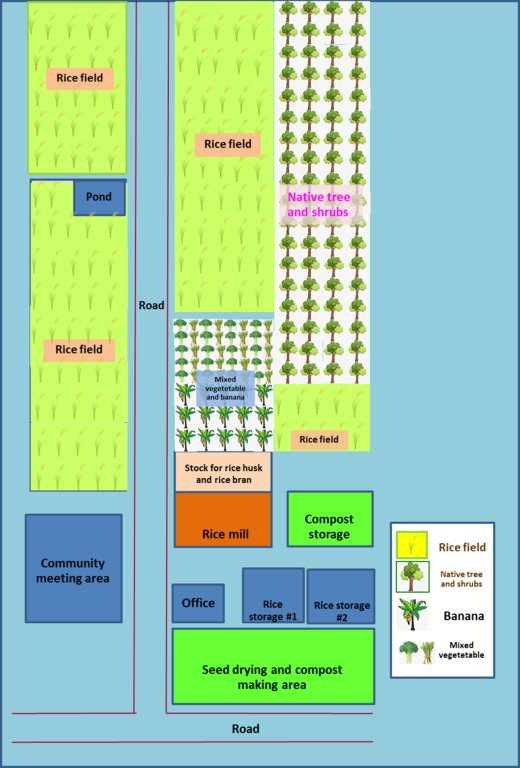Use of Organic Fertilizers for Organic Crop Pproduction on Infertile Soil [Thailand]
- Creation:
- Update:
- Compiler: Suwannapa B00njongrak
- Editor: –
- Reviewers: Rima Mekdaschi Studer, Samran Sombatpanit
technologies_4176 - Thailand
View sections
Expand all Collapse all1. General information
1.2 Contact details of resource persons and institutions involved in the assessment and documentation of the Technology
Key resource person(s)
SLM specialist:
Namsai Yuthasong
SLM specialist:
Suthakum Ratana
Thailand
SLM specialist:
Kaoya Putchanee
Thailand
national consultant:
Arunin Somsri
Land Development Department
Thailand
Name of project which facilitated the documentation/ evaluation of the Technology (if relevant)
Decision Support for Mainstreaming and Scaling out Sustainable Land Management (GEF-FAO / DS-SLM)Name of the institution(s) which facilitated the documentation/ evaluation of the Technology (if relevant)
Land Development Department LDD (Land Development Department LDD) - Thailand1.3 Conditions regarding the use of data documented through WOCAT
The compiler and key resource person(s) accept the conditions regarding the use of data documented through WOCAT:
Yes
1.4 Declaration on sustainability of the described Technology
Is the Technology described here problematic with regard to land degradation, so that it cannot be declared a sustainable land management technology?
No
Comments:
This is the main technology supporting organic farming which is the process accepted by the whole world because it concerns the food stability and security.
1.5 Reference to Questionnaire(s) on SLM Approaches (documented using WOCAT)
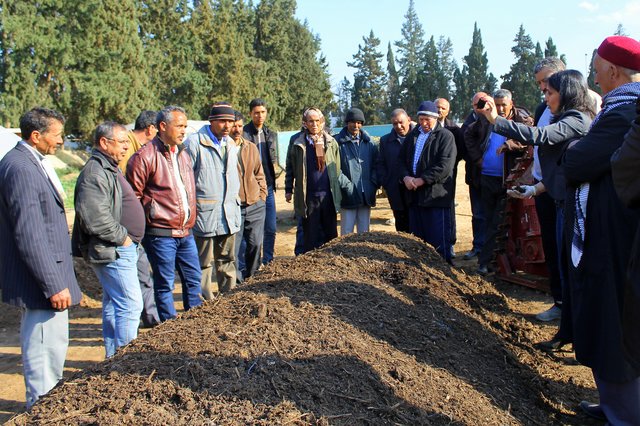
Immense demande de valorisation des dêchets et amélioration … [Tunisia]
Une immense demande de la technique du compostage comme une solution environmentale et écologique pour la gestion des dêchets et un traitement obligatoire des dechets organiques en agriculture biologique.
- Compiler: Donia Mühlematter
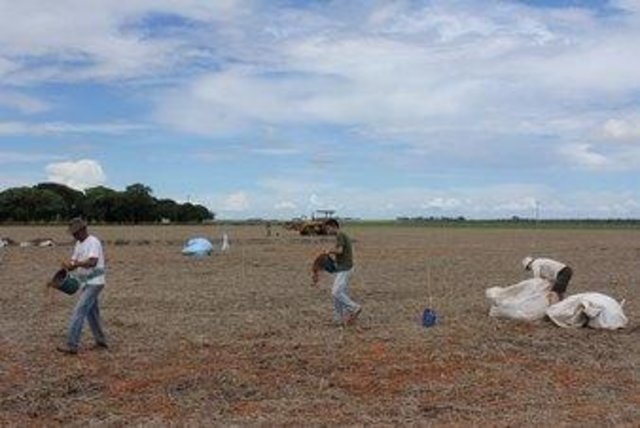
Enrichment of Tropical Agricultural Soil with Organic Matter [Brazil]
Enrichment of tropical agicultural soils with local available organic matter in the cerrado agroscape, Brazil.
- Compiler: Luisa F. Vega
2. Description of the SLM Technology
2.1 Short description of the Technology
Definition of the Technology:
The organic farming was initiated by a group of Yasothon farmers since 1989 to produce organic rice and vegetables. The organic fertilizers used are the compost made from farm products and animal dungs, bio-fermented liquid from kitchen wastes and crotalaria as green manure.
2.2 Detailed description of the Technology
Description:
Organic farming has become a national agenda with cross collaboration among government organizations concerned, local community administration, private sectors and farmers. This technology has scaled up to 253 farmers on 6,000 rai (6.25 rai = 1 ha) at Ban Sokkompoon, Naso Sub-district, Kutchum District, Yasothon Province. The information has been received from Mr. Man Samsee, chief of the community and a farmer himself. The organic fertilizers used in the farmers’ fields are the compost from farm products and animal dungs, bio-fermented liquid from kitchen wastes, fermented liquid from neem (Azadirachta indica) for pest control, and green manure from Crotalaria juncia. The crops grown have been rice and vegetables, medicinal herbs and sesame, which are certified as organic products; they command higher prices (more than 20%). Compost is the main organic fertilizer compared to others.
The objectives of organic farming are to produce organic crops, improve soil fertility, reduce wastes for friendly environment, get higher income and enhance good health for both producers and consumers. The procedure of making compost: The materials used for making compost are 1,000 kg of burnt rice husk, 3,000 kg of cattle manure/poultry manure, 3,000 kg of farm residues, 1,000 kg of coarse bran, 500 kg of fine bran, 1,000 kg of rice husk and 500 liters of organic-fermented liquid, all being thoroughly mixed by using a tractor. The allocation of compost: an amount of 300 kg of compost (20 bags) is given to each member to ferment at the farm by turning the bags occasionally before applying to a 3-rai land. There are several government organizations and private sectors that support this community of farmers, and a learning center was thus established. Up to now, the Land Development Department has been providing the knowledge of making compost and bio-fertilizer liquid; It also has been distributing green mature seeds and activators of bacteria and fungi. The Department of Agricultural Extension provided funding to establish the learning and training center and to produce materials used for training together with private sectors under CSR (Corporate Social Responsibility). The Cooperative Promotion Department supported by keeping household accounts. The local community administration set up several market places and promoted the products to be purchased by hospitals and restaurants. The organic crop products have been certified by OACT (Organic Agriculture Certification of Thailand) and IFOAM (International Federation of Organic Agriculture Movements). The Department of Groundwater provided groundwater by drilling holes at 30-40 m deep. The Department of Alternative Energy Development and Efficiency provided solar cells as the source of energy. The noticeable benefit of organic farming is that farmers have better health, the soil has become more fertile and the expenditure decreased. The farmers have been satisfied of their own lifestyle and did not migrate to the city. They have been committed to developing their land by using organic fertilizers continuously. The average income has increased from 7,500 THB/rai to 12,000 THB/rai. The main problem has been the transportation of the organic fertilizers which are bulky, but it can be overcome by producing them on site where needed.
2.3 Photos of the Technology
General remarks regarding photos:
Farmers are carrying compost bags allocated to them for their own use.
2.4 Videos of the Technology
Date:
28/11/2018
2.5 Country/ region/ locations where the Technology has been applied and which are covered by this assessment
Country:
Thailand
Region/ State/ Province:
Yasothon
Further specification of location:
Ban Naso, Naso Sub-district, Kutchum District, Yasothon Province, Thailand
Specify the spread of the Technology:
- evenly spread over an area
If the Technology is evenly spread over an area, specify area covered (in km2):
960.0
If precise area is not known, indicate approximate area covered:
- 100-1,000 km2
Is/are the technology site(s) located in a permanently protected area?
No
Comments:
This area is rather flat, approx. 0-2% slope and thus no soil erosion. The fertility of the soil is low.
Map
×2.6 Date of implementation
Indicate year of implementation:
1989
If precise year is not known, indicate approximate date:
- 10-50 years ago
2.7 Introduction of the Technology
Specify how the Technology was introduced:
- through land users' innovation
- The land user got knowledge from training abroad.
3. Classification of the SLM Technology
3.1 Main purpose(s) of the Technology
- improve production
- reduce, prevent, restore land degradation
- create beneficial economic impact
3.2 Current land use type(s) where the Technology is applied
Land use mixed within the same land unit:
No

Cropland
- Annual cropping
Annual cropping - Specify crops:
- cereals - rice (wetland)
Number of growing seasons per year:
- 1
Specify:
Khao Dok Mali 105 rice variety (Jasmine Rice)
Is intercropping practiced?
No
Is crop rotation practiced?
No
3.3 Has land use changed due to the implementation of the Technology?
Has land use changed due to the implementation of the Technology?
- No (Continue with question 3.4)
Land use mixed within the same land unit:
No

Cropland
3.4 Water supply
Water supply for the land on which the Technology is applied:
- rainfed
Comments:
The rainfall in this area was 1,562 mm/yr in 30-year period (1981-2010).
3.5 SLM group to which the Technology belongs
- integrated crop-livestock management
- improved ground/ vegetation cover
- integrated soil fertility management
3.6 SLM measures comprising the Technology

agronomic measures
- A2: Organic matter/ soil fertility
3.7 Main types of land degradation addressed by the Technology

chemical soil deterioration
- Cn: fertility decline and reduced organic matter content (not caused by erosion)

physical soil deterioration
- Pu: loss of bio-productive function due to other activities

biological degradation
- Bc: reduction of vegetation cover
Comments:
The land degradation has been caused by man, e.g. deforestation, the overuse of agricultural chemical substances.
3.8 Prevention, reduction, or restoration of land degradation
Specify the goal of the Technology with regard to land degradation:
- prevent land degradation
- reduce land degradation
Comments:
The organic fertilizer/ compost could improve soil structure, reduce bulk density, increase soil aeration, easy to plough, decrease the hard pan and spread out the plant roots. Consequently, plant roots could absorb more nutrients.
4. Technical specifications, implementation activities, inputs, and costs
4.1 Technical drawing of the Technology
Technical specifications (related to technical drawing):
The method of making compost of Naso Rice Farmer Group can be described as follows: 1) the ingredients are 1,000 kg of chicken manure, 1,000 kg of cattle manure, 1,000 kg of poultry manure, 1,000 kg of top soil, 500 liter of bio-fermented liquid and 1,000 kg of filter cake; 2) mix all of these ingredients and pack in the bags; 3) distribute these bags to the members for making compost at their home; and 4) when the compost decomposes completely, it can be applied in paddy fields at the rate of 1,280 kg/rai (8,000 kg/ha).
Author:
Miss Kanokwan Hansookjaichareon
Date:
09/10/2018
4.2 General information regarding the calculation of inputs and costs
Specify how costs and inputs were calculated:
- per Technology area
Indicate size and area unit:
1 rai
If using a local area unit, indicate conversion factor to one hectare (e.g. 1 ha = 2.47 acres): 1 ha =:
1 ha = 6.25 rai
other/ national currency (specify):
THB
If relevant, indicate exchange rate from USD to local currency (e.g. 1 USD = 79.9 Brazilian Real): 1 USD =:
32.0
Indicate average wage cost of hired labour per day:
300 THB
4.3 Establishment activities
| Activity | Timing (season) | |
|---|---|---|
| 1. | Gathering the materials | December-April |
| 2. | Making compost | December-April |
| 3. | Applying to paddy field | May-June |
Comments:
The kinds of materials may differ according to the amount of residues at that time.
4.4 Costs and inputs needed for establishment
| Specify input | Unit | Quantity | Costs per Unit | Total costs per input | % of costs borne by land users | |
|---|---|---|---|---|---|---|
| Labour | Labour for making compost | Man-day | 8.0 | 300.0 | 2400.0 | |
| Equipment | Tractor | hour | 2.5 | 1250.0 | 3125.0 | |
| Equipment | Transportation cost | hour | 1.5 | 350.0 | 525.0 | |
| Plant material | Animal manures, burned rice husk, bran | kg | 10000.0 | 0.655 | 6550.0 | |
| Total costs for establishment of the Technology | 12600.0 | |||||
| Total costs for establishment of the Technology in USD | 393.75 | |||||
If land user bore less than 100% of costs, indicate who covered the remaining costs:
Naso Rice Farmer Group
4.5 Maintenance/ recurrent activities
| Activity | Timing/ frequency | |
|---|---|---|
| 1. | Turn the compost bags during fermentation process. | Every week until 75 days |
4.6 Costs and inputs needed for maintenance/ recurrent activities (per year)
| Specify input | Unit | Quantity | Costs per Unit | Total costs per input | % of costs borne by land users | |
|---|---|---|---|---|---|---|
| Labour | Turn the compost bags during fermentation process | Day | 1.0 | 300.0 | 300.0 | |
| Total costs for maintenance of the Technology | 300.0 | |||||
| Total costs for maintenance of the Technology in USD | 9.38 | |||||
If land user bore less than 100% of costs, indicate who covered the remaining costs:
Land Development Department
4.7 Most important factors affecting the costs
Describe the most determinate factors affecting the costs:
Most of the costs depend on raw material price and wages cost (both labour and equipment)
5. Natural and human environment
5.1 Climate
Annual rainfall
- < 250 mm
- 251-500 mm
- 501-750 mm
- 751-1,000 mm
- 1,001-1,500 mm
- 1,501-2,000 mm
- 2,001-3,000 mm
- 3,001-4,000 mm
- > 4,000 mm
Specify average annual rainfall (if known), in mm:
1600.00
Specifications/ comments on rainfall:
There are 3 seasons in Yasothon, i.e. hot, rainy, and cool seasons. The average relative humidity is 71.1%. Maximum temperature is 42 degree celsius, minimum temperature is 11 degree celsius.
Indicate the name of the reference meteorological station considered:
Meteorological Department
Agro-climatic zone
- semi-arid
5.2 Topography
Slopes on average:
- flat (0-2%)
- gentle (3-5%)
- moderate (6-10%)
- rolling (11-15%)
- hilly (16-30%)
- steep (31-60%)
- very steep (>60%)
Landforms:
- plateau/plains
- ridges
- mountain slopes
- hill slopes
- footslopes
- valley floors
Altitudinal zone:
- 0-100 m a.s.l.
- 101-500 m a.s.l.
- 501-1,000 m a.s.l.
- 1,001-1,500 m a.s.l.
- 1,501-2,000 m a.s.l.
- 2,001-2,500 m a.s.l.
- 2,501-3,000 m a.s.l.
- 3,001-4,000 m a.s.l.
- > 4,000 m a.s.l.
Indicate if the Technology is specifically applied in:
- not relevant
5.3 Soils
Soil depth on average:
- very shallow (0-20 cm)
- shallow (21-50 cm)
- moderately deep (51-80 cm)
- deep (81-120 cm)
- very deep (> 120 cm)
Soil texture (topsoil):
- medium (loamy, silty)
Soil texture (> 20 cm below surface):
- medium (loamy, silty)
Topsoil organic matter:
- low (<1%)
5.4 Water availability and quality
Ground water table:
5-50 m
Availability of surface water:
good
Water quality (untreated):
for agricultural use only (irrigation)
Water quality refers to:
surface water
Is water salinity a problem?
No
Is flooding of the area occurring?
No
5.5 Biodiversity
Species diversity:
- medium
Habitat diversity:
- medium
5.6 Characteristics of land users applying the Technology
Sedentary or nomadic:
- Sedentary
Market orientation of production system:
- mixed (subsistence/ commercial)
Off-farm income:
- less than 10% of all income
Relative level of wealth:
- rich
Individuals or groups:
- individual/ household
Level of mechanization:
- manual work
- mechanized/ motorized
Gender:
- men
Age of land users:
- elderly
5.7 Average area of land used by land users applying the Technology
- < 0.5 ha
- 0.5-1 ha
- 1-2 ha
- 2-5 ha
- 5-15 ha
- 15-50 ha
- 50-100 ha
- 100-500 ha
- 500-1,000 ha
- 1,000-10,000 ha
- > 10,000 ha
Is this considered small-, medium- or large-scale (referring to local context)?
- medium-scale
Comments:
The holding areas of the land users in the Northeast of Thailand are about 3.2-4.8 ha per household.
5.8 Land ownership, land use rights, and water use rights
Land ownership:
- individual, titled
Land use rights:
- open access (unorganized)
Water use rights:
- individual
Are land use rights based on a traditional legal system?
Yes
Comments:
The land owners have full right in their land, so they are able to manage and develop their land.
5.9 Access to services and infrastructure
health:
- poor
- moderate
- good
education:
- poor
- moderate
- good
technical assistance:
- poor
- moderate
- good
employment (e.g. off-farm):
- poor
- moderate
- good
markets:
- poor
- moderate
- good
energy:
- poor
- moderate
- good
roads and transport:
- poor
- moderate
- good
drinking water and sanitation:
- poor
- moderate
- good
financial services:
- poor
- moderate
- good
6. Impacts and concluding statements
6.1 On-site impacts the Technology has shown
Socio-economic impacts
Production
crop production
crop quality
forest/ woodland quality
land management
Income and costs
expenses on agricultural inputs
farm income
diversity of income sources
workload
Socio-cultural impacts
food security/ self-sufficiency
health situation
land use/ water rights
cultural opportunities
recreational opportunities
community institutions
national institutions
SLM/ land degradation knowledge
situation of socially and economically disadvantaged groups
Ecological impacts
Water cycle/ runoff
water quality
surface runoff
excess water drainage
groundwater table/ aquifer
evaporation
Soil
soil moisture
soil cover
soil accumulation
soil crusting/ sealing
soil compaction
nutrient cycling/ recharge
salinity
soil organic matter/ below ground C
acidity
Biodiversity: vegetation, animals
Vegetation cover
biomass/ above ground C
plant diversity
invasive alien species
animal diversity
beneficial species
habitat diversity
Climate and disaster risk reduction
emission of carbon and greenhouse gases
6.2 Off-site impacts the Technology has shown
reliable and stable stream flows in dry season
downstream flooding
groundwater/ river pollution
buffering/ filtering capacity
impact of greenhouse gases
6.3 Exposure and sensitivity of the Technology to gradual climate change and climate-related extremes/ disasters (as perceived by land users)
Gradual climate change
Gradual climate change
| Season | increase or decrease | How does the Technology cope with it? | |
|---|---|---|---|
| annual temperature | increase | moderately | |
| seasonal temperature | summer | increase | moderately |
| seasonal temperature | wet/ rainy season | increase | moderately |
| annual rainfall | increase | moderately |
Climate-related extremes (disasters)
Meteorological disasters
| How does the Technology cope with it? | |
|---|---|
| local rainstorm | moderately |
| local thunderstorm | moderately |
| local hailstorm | moderately |
Climatological disasters
| How does the Technology cope with it? | |
|---|---|
| drought | moderately |
Biological disasters
| How does the Technology cope with it? | |
|---|---|
| epidemic diseases | moderately |
| insect/ worm infestation | moderately |
Other climate-related consequences
Other climate-related consequences
| How does the Technology cope with it? | |
|---|---|
| extended growing period | moderately |
| reduced growing period | moderately |
Comments:
The changes of environment have rather low effects to organic fertilizer production technology.
6.4 Cost-benefit analysis
How do the benefits compare with the establishment costs (from land users’ perspective)?
Short-term returns:
slightly positive
Long-term returns:
positive
Comments:
There are no maintenance expenses on this technology because it is consumable.
6.5 Adoption of the Technology
- single cases/ experimental
Of all those who have adopted the Technology, how many did so spontaneously, i.e. without receiving any material incentives/ payments?
- 51-90%
6.6 Adaptation
Has the Technology been modified recently to adapt to changing conditions?
Yes
other (specify):
changing upon materials in the local area
Specify adaptation of the Technology (design, material/ species, etc.):
The materials for making compost might be changed; for example, filter cake might be changed to water hyacinth or other aqua weeds.
6.7 Strengths/ advantages/ opportunities of the Technology
| Strengths/ advantages/ opportunities in the land user’s view |
|---|
| The organic fertilizers are suitable for soil improvement, thus increasing soil fertility. |
| The use of organic fertilizers can reduce the use of chemical fertilizers. |
| It is a wise alternative to use agricultural residues to obtain more benefits. |
| Develop bargaining power to sell the products. |
| Strengths/ advantages/ opportunities in the compiler’s or other key resource person’s view |
|---|
| The farmers have high leadership and high self-reliance. |
| The farmers have multi-knowledge which can be adapted to the farm activities. |
| The organic fertilizer is the key factor for organic farming. |
| The organic fertilizer can promote the utilization of local residues sustainably. |
6.8 Weaknesses/ disadvantages/ risks of the Technology and ways of overcoming them
| Weaknesses/ disadvantages/ risks in the land user’s view | How can they be overcome? |
|---|---|
| The organic fertilizer transportation is a hard work. | The organic fertilizer can be produced in paddy fields. |
| Weaknesses/ disadvantages/ risks in the compiler’s or other key resource person’s view | How can they be overcome? |
|---|---|
| Some farmers do not have the confidence in using organic fertilizer. | Responsible persons are urged to do more in the matter of technology transfer to effectively increase the understanding of farmers. |
7. References and links
7.1 Methods/ sources of information
- field visits, field surveys
16 land users, 1 local administrator, 1 miller, 1 farmer leader
- interviews with land users
56 farmers
- interviews with SLM specialists/ experts
2 informants
When were the data compiled (in the field)?
10/10/2018
Comments:
Interviews started 10/10/2018 - 2/11/2018
7.2 References to available publications
Title, author, year, ISBN:
Organic fertilizer, production, using, and quality. Department of Agriculture. 2005. ISBN 974-436-479-3
Available from where? Costs?
http://aglib.doa.go.th/lib/images/Downloads/2549/EB00280.pdf
7.3 Links to relevant online information
Title/ description:
Organic fertilizer, production, using, and quality. Department of Agriculture. 2005. ISBN 974-436-479-3
URL:
http://aglib.doa.go.th/lib/images/Downloads/2549/EB00280.pdf
7.4 General comments
where the land is greener : WOCAT
Links and modules
Expand all Collapse allLinks

Immense demande de valorisation des dêchets et amélioration … [Tunisia]
Une immense demande de la technique du compostage comme une solution environmentale et écologique pour la gestion des dêchets et un traitement obligatoire des dechets organiques en agriculture biologique.
- Compiler: Donia Mühlematter

Enrichment of Tropical Agricultural Soil with Organic Matter [Brazil]
Enrichment of tropical agicultural soils with local available organic matter in the cerrado agroscape, Brazil.
- Compiler: Luisa F. Vega
Modules
No modules


